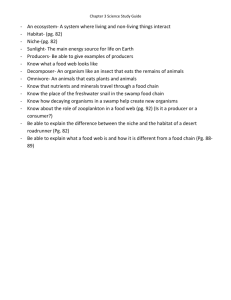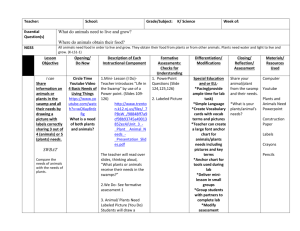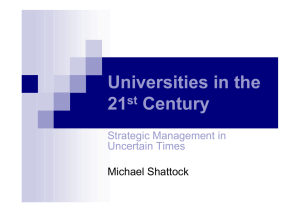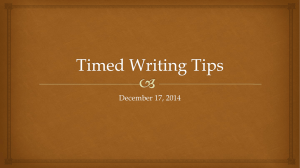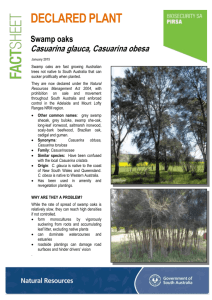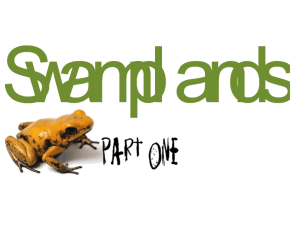ENVIRONMENTAL LAW
advertisement
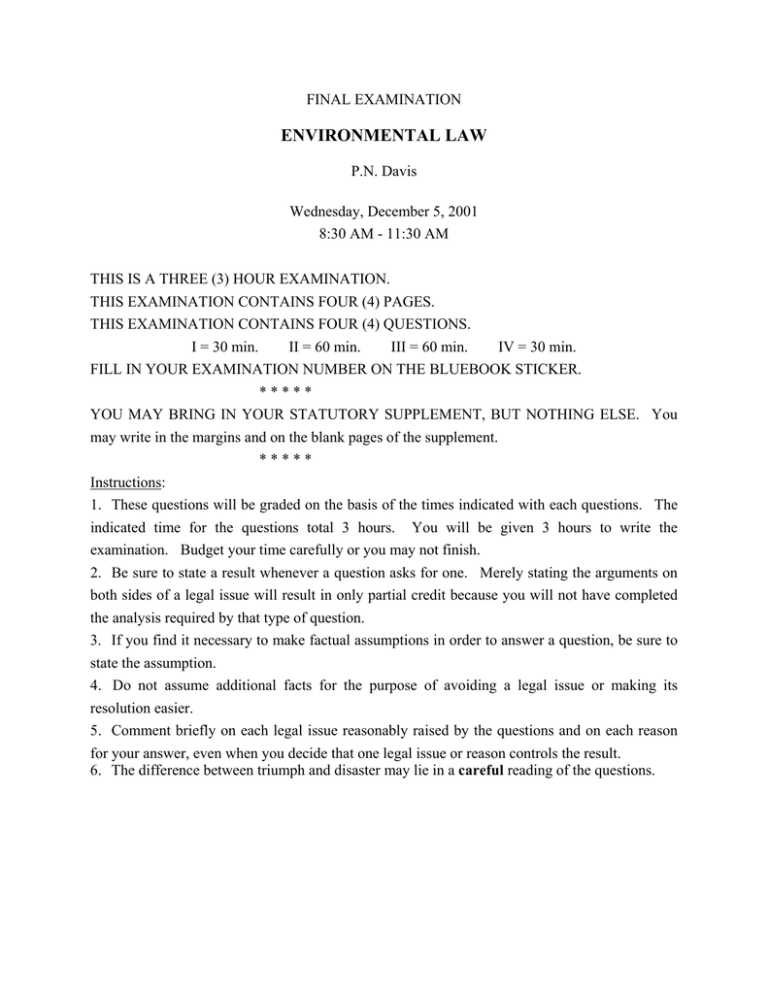
FINAL EXAMINATION ENVIRONMENTAL LAW P.N. Davis Wednesday, December 5, 2001 8:30 AM - 11:30 AM THIS IS A THREE (3) HOUR EXAMINATION. THIS EXAMINATION CONTAINS FOUR (4) PAGES. THIS EXAMINATION CONTAINS FOUR (4) QUESTIONS. I = 30 min. II = 60 min. III = 60 min. IV = 30 min. FILL IN YOUR EXAMINATION NUMBER ON THE BLUEBOOK STICKER. ***** YOU MAY BRING IN YOUR STATUTORY SUPPLEMENT, BUT NOTHING ELSE. You may write in the margins and on the blank pages of the supplement. ***** Instructions: 1. These questions will be graded on the basis of the times indicated with each questions. The indicated time for the questions total 3 hours. You will be given 3 hours to write the examination. Budget your time carefully or you may not finish. 2. Be sure to state a result whenever a question asks for one. Merely stating the arguments on both sides of a legal issue will result in only partial credit because you will not have completed the analysis required by that type of question. 3. If you find it necessary to make factual assumptions in order to answer a question, be sure to state the assumption. 4. Do not assume additional facts for the purpose of avoiding a legal issue or making its resolution easier. 5. Comment briefly on each legal issue reasonably raised by the questions and on each reason for your answer, even when you decide that one legal issue or reason controls the result. 6. The difference between triumph and disaster may lie in a careful reading of the questions. I. (30 minutes) Ruth Morse is a weaver. Near her house in the country is a bald eagle aerie (nest). She picks up eagle feathers found on the ground under their aerie and fastens them in the woven scarves and sweaters she makes and sells at craft shows. The eagles do not seem to be disturbed by her occasional presence under their aerie. Bald eagles are listed in the Federal Register as an endangered species. Hilda Birdwatcher personally saw some of Morse’s weavings at a craft show and brought suit against her in federal court to enjoin Morse from using the feathers in weavings in the future and to remove the feathers in weavings still in her possession. Birdwatcher lives in a different city than Morse, does not know her, and has never been on or near her property. Birdwatcher is a member of the National Audubon Society and participates in its annual Winter Bird Population Count. Should the court grant the requested injunction against Morse? Assume that Birdwatcher notified the U.S. Attorney’s Office, which sent Morse a letter, but took no other action. Discuss all relevant legal issues. State a result. 1 II (60 minutes) Midwestern Power Company plans to construct a new very high voltage transmission line across the State of Jefferson. The line is routed to cross the Great Cattail Swamp, an area of two square miles. Ten transmission line towers must be built in the swamp. The tower foundations, each 100 feet square, will be placed on pads composed exclusively of material dredged from beneath the swamp bed immediately around the tower sites and piled up to a level 3 feet above the high water line in the swamp. No additional material will be brought in from elsewhere. The towers will be standards 125 foot tall pylons common in rural areas of the United States. Six wires will be hung from long insulators. (The wires do not pose an electrocution hazard to birds because even the largest waterfowl are far too small to bridge the electrical circuit; the wires have a spacing of about 25 feet.) During heavy rainfall periods, the swamp overflows through a small intermittent stream into Herman Branch, a tributary of the Jefferson River. But during much of the year, no water drains from the swamp, although there is standing water in both open water areas and among the swamp plants year round. Currently, the swamp is habitat for waterfowl during the spring and fall migrations. Also, it is summer habitat for red-winged blackbirds. Muskrats live in the swamp year round. None of these species is endangered. Hunters come to the edge of the swamp to hunt the migrating waterfowl. Birdwatchers come year round. There was no historic transportation use of the swamp, but some fishing was and is done in open water areas of the swamp. Midwestern Power inquired of the Corps of Engineers whether it needs to apply for a permit for constructing the transmission tower bases in the swamp and whether it should prepare an environmental impact statement, as had been required in the past. This question has been referred to you as a Corps of Engineers attorney. How should you respond to those two questions? Discuss all relevant legal issues. State a result on each question. 2 III. (60 minutes) In 1992, Acme Battery Sales, Inc., bought a rural tract of land in the State of Jefferson from Omega Battery Co. Omega had owned the land since 1955 and used it to rehabilitate used automobile batteries. Batteries beyond repair were discarded in pits on the “back 40”, cases, lead plates, sulfuric acid and all. After purchase, Acme continued the same business and practices. In 1999, the drinking and livestock wells of their neighbor, Harry Steer, became contaminated with sulphuric acid. Testing of the well water showed lead contamination, as well. So far, no neighbors have had their wells contaminated. Steer wishes to sue anyone who is responsible for the contamination and to persuade any relevant regulatory agency to stop future contamination and to clean up past contamination. Assuming causation can be proved, does Steer have any cause of action available? Is there any regulatory agency which can take action? (Assume that the State of Jefferson has no state statutory authority to regulate Acme’s activities.) What regulatory actions are available? Discuss all relevant issues. State a result to each question. 3 IV. (30 minutes) (1) (2) (3) (4) (5) (6) (7) (8) (9) (10) Briefly define the following terms and abbreviations: public nuisance BACT nonpoint source SIP PRP NAAQS water quality standards national priority list generator balancing of the equities 4
